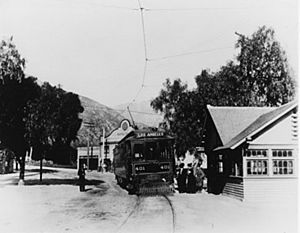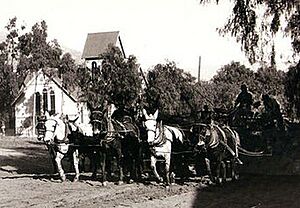Sierra Madre Line facts for kids
Quick facts for kids Sierra Madre |
|
|---|---|

Sierra Madre 1908 with PE line Depot and the Hotel Shirley in background
|
|
| Overview | |
| Owner | Southern Pacific Railroad |
| Locale | Southern California |
| Termini | Pacific Electric Building Sierra Madre, California |
| Stations | 24 |
| Service | |
| Type | Interurban |
| System | Pacific Electric |
| Operator(s) | Pacific Electric |
| Rolling stock | PE 1100 Class (last used) |
| Daily ridership | 1713 (last counted) |
| History | |
| Opened | January 1, 1906 |
| Closed | October 6, 1950 |
| Technical | |
| Line length | 16.52 mi (26.59 km) |
| Track gauge | 1,435 mm (4 ft 8 1⁄2 in) standard gauge |
| Electrification | 600 V DC Overhead lines |
The Sierra Madre Line was a special type of train route run by the Pacific Electric company. It was an interurban line, which means it connected cities and towns that were close to each other. This line traveled about 16.52 miles (26.59 km) from the Pacific Electric Building in Los Angeles all the way to Sierra Madre.
Contents
History of the Sierra Madre Train Line
The Sierra Madre Line first opened to Pasadena on March 19, 1904. Just two years later, in 1906, the line was made longer to reach Sierra Madre. On December 3, 1916, the way the trains traveled through Downtown Los Angeles was changed.
How Service Changed Over Time
By March 1, 1928, a new way of traveling began for evening trips. Passengers going to Sierra Madre from San Marino had to switch trains. They would get off one train and get on a different one, called the Monrovia–Glendora Line, to finish their journey.
In March 1939, some trains going to Glendora started dropping off their back car. This back car would then continue on to Sierra Madre. This became the only direct way to get to Sierra Madre starting February 21, 1943. After this, only trains during busy times (rush hour) from Monrovia served the line directly. All other trips during the middle of the day became shuttle services, meaning you had to change trains.
When Did the Line Stop Running?
On June 11, 1948, weekend and midday train services were stopped completely. All trips became shuttle services. A single morning trip from Los Angeles was added back after November 25, 1949.
However, on October 8, 1950, almost all train service on the line ended. Only one round trip ran between Sierra Madre and San Marino. This last bit of service finally stopped on December 28, 1950. After the trains stopped running, the Pacific Electric company continued to offer transportation using buses instead.
What Was the Sierra Madre Line Route Like?
The Sierra Madre Line branched off from another train line, the Monrovia–Glendora Line, in a place called San Marino. The Sierra Madre Line had two tracks that ran between two roads. It passed by Lamanda Park Junction, where it met another local train line.
From Lamanda Park Junction, the line continued north on a single track. This track was on its own special path in the middle of Sierra Madre Boulevard. When it reached Michillinda Avenue, the tracks moved onto the city streets. The trains then traveled on Central Avenue (which was also Sierra Madre Boulevard) to Baldwin Avenue in Sierra Madre. This is where the main station was located.
The line then continued north for about one and a half blocks on Baldwin Avenue. It turned east onto another private path, located between Montecito Avenue and Highland Avenue. This was the very end of the line, where there was a small area to store trains.
Major Stations Along the Line
Here are some of the important stations that the Sierra Madre Line stopped at:


